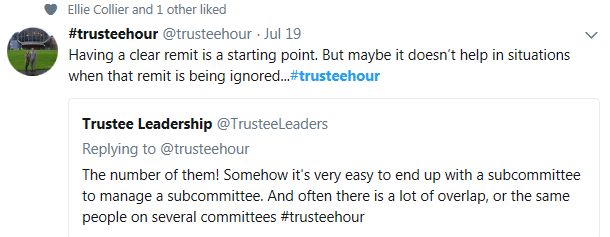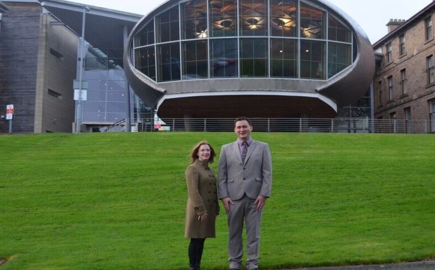With over 3,500 views, our July #trusteehour looked at charity sub-committees, and the ups and downs shared by followers online. It looks like some of you really value the blog to bring together the contributions into one summary – thanks for getting in touch @JanineEEdwards

Charity sub-committees can come in all sorts of shapes and sizes. Whether it’s Finance, Fundraising, Nominations, HR or Audit, there are plenty of examples of boards delegating to smaller working groups. Are these committees always effective? @sallyld drew out a few examples of what can make a committee worthwhile:
@sallyld replying to @trusteehour
Ah sub committees. They can be brilliant with a tight remit, clear reporting structures and a clear review process. Otherwise steer well clear (in my opinion).
Committees can be a necessary way to focus on delivery of the board’s strategy and objectives, as @ian_mcl points out – a board does not have time to get into the detail of everything, and needs to find mechanisms to support delivery and oversight:
@Ian_mcl replying to @TrusteeLeaders @trusteehour
4 board meetings pa for 3 hrs is 12 hours a year to do everything. Create work plan and delegate spadework to cttees to get coverage without having too many. Driven by board objectives.
However, there were some examples of poor time management, which raises questions about how meetings are being chaired:

And Ian wasn’t alone in that experience.
We returned to the theme of the importance of a tight remit, and the way things can become inefficient if not handled well:

Another angle we drew attention to was the opportunity offered by a committee role, as a first experience of charity governance, or a means to share your expertise without the full commitment of a trustee role. A number of charties do co-opt external members. External members can share their expertise on whichever sub-committee they sit, although don’t attend board meetings and are usually not trustees.
We would like to encourage more charities to consider co-opting new members onto their sub-committees. This could be a win-win. A great way for someone new to charity governance to gain some first experience and volunteer in a way which is less onerous than a full board role. It enables them to get to know a charity, where later they may consider a trustee role when a vacancy arises. This ‘getting to know you’ process works both ways, and it could also prove particularly useful as a way to involve younger people in their first role:
@TraceyMcCillen replying to @trusteehour
Will certainly give it some thought and let you know. Keen to engage Young Trustees and see change in perception on how people with learning disability can engage at all levels of governance, Board, Committees etc.
If your charity could create a committee role to expand the pipeline of future trustees, there’s a place on twitter where vacancies can be shared:

Finally, join us for our next #trusteehour on Tuesday 14th August, 7-8pm (note earlier time) where @TheYardScotland is hosting us as we look at top tips for charities embarking on a capital build project, a theme we’re supporting to help the Yard with their forthcoming new project. We’re keen to continue to take #trusteehour on tour – if your charity has a specific area of interest for a future #trusteehour, get in touch with us @trusteehour!
Blog by Julie Hutchison @juliekhutchison
Founding Editor of @InformedTrustee
12 August 2018
